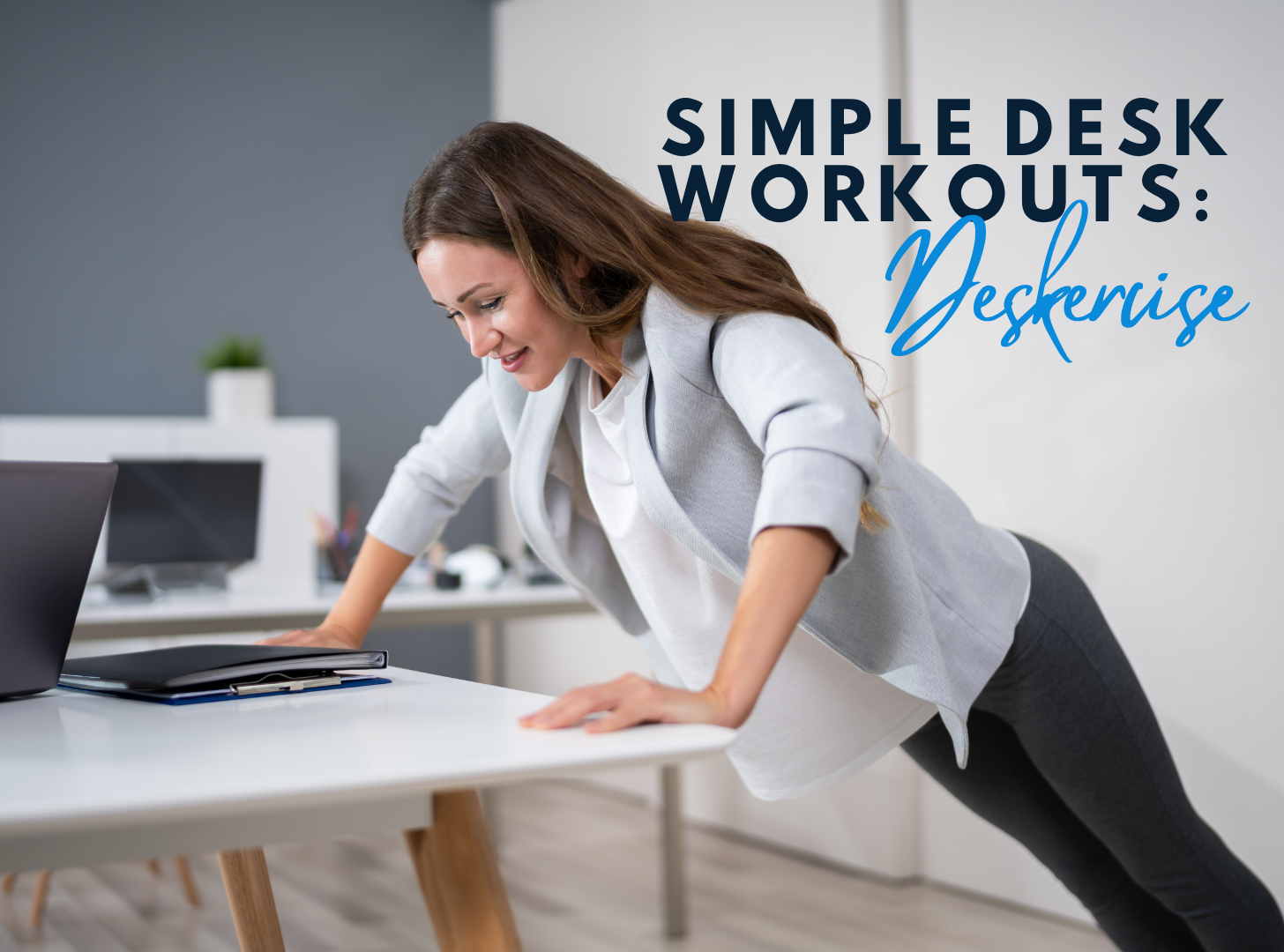
Deskercise: Simple Desk Workouts to Boost Your Energy and Productivity
If you’re like many people, your workday is spent sitting at a desk, typing away at the computer, or answering calls.
As convenient as it may be, prolonged sitting is a recipe for discomfort and a range of health issues, including back pain, neck stiffness, and poor posture. But there’s good news! You don’t have to leave your desk or spend hours at the gym to stay active. With simple desk exercises—also known as deskercise—you can break up the monotony, reduce pain, and boost your energy levels throughout the day.
In The Wellness Blueprint, a comprehensive guide to creating a balanced and healthy lifestyle, the importance of integrating movement into your daily routine is emphasized. It’s not just about hitting the gym; it’s about finding ways to weave wellness into your everyday activities. Even if you have a desk job, there are plenty of ways to stay active and support your health. Deskercise is a fun and easy way to ensure you’re getting the movement your body needs without sacrificing productivity.
Here are some simple and effective desk workouts you can do to stay energized and reduce the negative effects of sitting all day. Incorporating these exercises into your workday can have a significant impact on your physical and mental well-being.
1. Standing Desk Workout
If you’re using a standing desk, you’re already one step ahead. Standing allows for more natural movement and can reduce the strain on your lower back and legs. But it’s important not to stand still for too long either. Adding some light movement while standing can help keep your muscles engaged and your body active. Here are a few simple exercises to do at your standing desk:
- Standing calf raises: Stand tall with your feet hip-width apart. Slowly rise onto your toes, hold for a second, and then lower back down. Repeat 10-15 times. This exercise helps strengthen your calves and promotes blood circulation, preventing your legs from feeling tired or stiff.
- Standing leg lifts: Stand tall and lift one leg in front of you, holding it for a few seconds, then slowly lower it back down. Switch to the other leg. This exercise strengthens the muscles in your legs and improves balance, which is essential if you’re spending long hours standing.
- Hip rotations: Gently rotate your hips in circular motions while standing to loosen up tight hips, which is common after sitting for long periods. This can also help with mobility and reduce discomfort in the lower back.
2. Desk Stretches for Back
One of the biggest complaints from desk workers is back pain. Sitting for extended hours, especially in poor posture, can lead to tension in the lower back and spine. Regular desk stretches can help release that tension and improve flexibility.
- Seated spinal twists: Sit up straight in your chair with your feet flat on the floor. Place your left hand on the back of your chair and your right hand on your left knee. Gently twist your torso to the left, hold for 10-15 seconds, and then return to the center. Repeat on the other side. This stretch helps loosen up your back and improves spinal mobility.
- Back stretches at your desk: While seated, reach both arms overhead, interlace your fingers, and stretch up as high as you can. Hold for a deep breath, and then gently lean to each side, feeling the stretch along your spine. This helps reduce stiffness and encourages better posture.
3. Leg Desk Exercises
Sitting for hours can cause your legs to feel stiff and tired, which can negatively affect circulation and lead to discomfort. Simple leg exercises can help get your blood flowing again and prevent fatigue.
- Leg extensions: While seated, extend one leg out straight and hold it parallel to the floor for a few seconds, then lower it back down. Repeat this exercise 10 times on each leg. Leg extensions help strengthen your quads and improve circulation in your legs.
- Leg raises: While sitting, lift one leg off the floor, keeping your knee bent at a 90-degree angle. Hold it for 5-10 seconds and then slowly lower it back down. Switch to the other leg. This simple leg raise is a great way to engage your hip flexors and strengthen your thighs without leaving your chair.
4. Simple Office Exercises
Incorporating light movement into your workday can make a world of difference to your physical health. These simple office exercises require little to no space, and they can help break up long periods of sitting:
- Shoulder rolls: Sit up straight and relax your shoulders. Slowly roll your shoulders forward in a circular motion 5-10 times, then reverse the direction. This simple movement relieves tension in your shoulders and upper back, improving circulation and posture.
- Neck stretches: Neck tension is another common issue caused by sitting at a desk for long periods. To release stiffness, gently lower your chin to your chest, then slowly roll your neck in a circular motion. Repeat the stretch 5-10 times. You can also tilt your head to the left and right, holding each side for 10-15 seconds to deepen the stretch and release tension.
- Wrist and hand stretches: After typing for hours, your wrists and hands may become stiff and sore. Perform simple hand and wrist stretches to alleviate discomfort. Stretch your fingers wide, make fists, and roll your wrists in circles. These stretches will help prevent carpal tunnel syndrome and improve your hand’s range of motion.
5. Cubicle Workout
Even if you’re confined to a small cubicle, there’s still plenty of movement you can do. These quick exercises require little space and can be done discreetly during breaks or while on a conference call:
- Chair squats: Stand in front of your chair with your feet shoulder-width apart. Lower yourself down as if you were going to sit in your chair, but stop just before you do. Rise back up to standing. Repeat this 10-15 times. This strengthens your legs, glutes, and core, and helps you maintain good posture.
- Tricep dips: Place your hands on the edge of your chair, palms facing down. Slide your hips off the edge and lower your body down by bending your elbows. Push back up to the starting position. Repeat 10-15 times. Tricep dips help tone your arms and improve upper body strength.
The Benefits of Desk Movement
By incorporating deskercise into your workday, you can experience a wide range of benefits:
- Reduced pain and discomfort: Regular movement helps prevent stiffness in your neck, back, and legs, reducing the risk of chronic pain and tension.
- Improved posture: Desk exercises that focus on stretching and strengthening muscles help you maintain proper posture, which is essential for preventing pain and injury.
- Increased energy and focus: Movement increases blood flow and oxygen to your brain, which can help you stay alert, focused, and productive throughout the day.
- Boosted mood and reduced stress: Desk exercises stimulate the release of endorphins, which are natural mood boosters. Taking a break for movement can help relieve stress and improve your overall well-being.
Conclusion
Staying active at work doesn’t require expensive equipment or a trip to the gym. Simple desk exercises can help you stay energized, reduce pain, and improve your productivity throughout the day. As highlighted in The Wellness Blueprint, it’s about making small, sustainable changes to your routine that support your overall health and well-being. By incorporating these simple desk workouts into your daily routine, you can make wellness a part of your workday, one movement at a time.
Remember, every little bit counts. Whether it’s a quick stretch, a standing desk workout, or some simple leg exercises at your desk, moving throughout the day will keep you feeling better, both physically and mentally.
Be the First to Know
Sign up for exclusive sneak peeks, ARC opportunities, reader discounts, and behind-the-scenes updates on upcoming releases.

